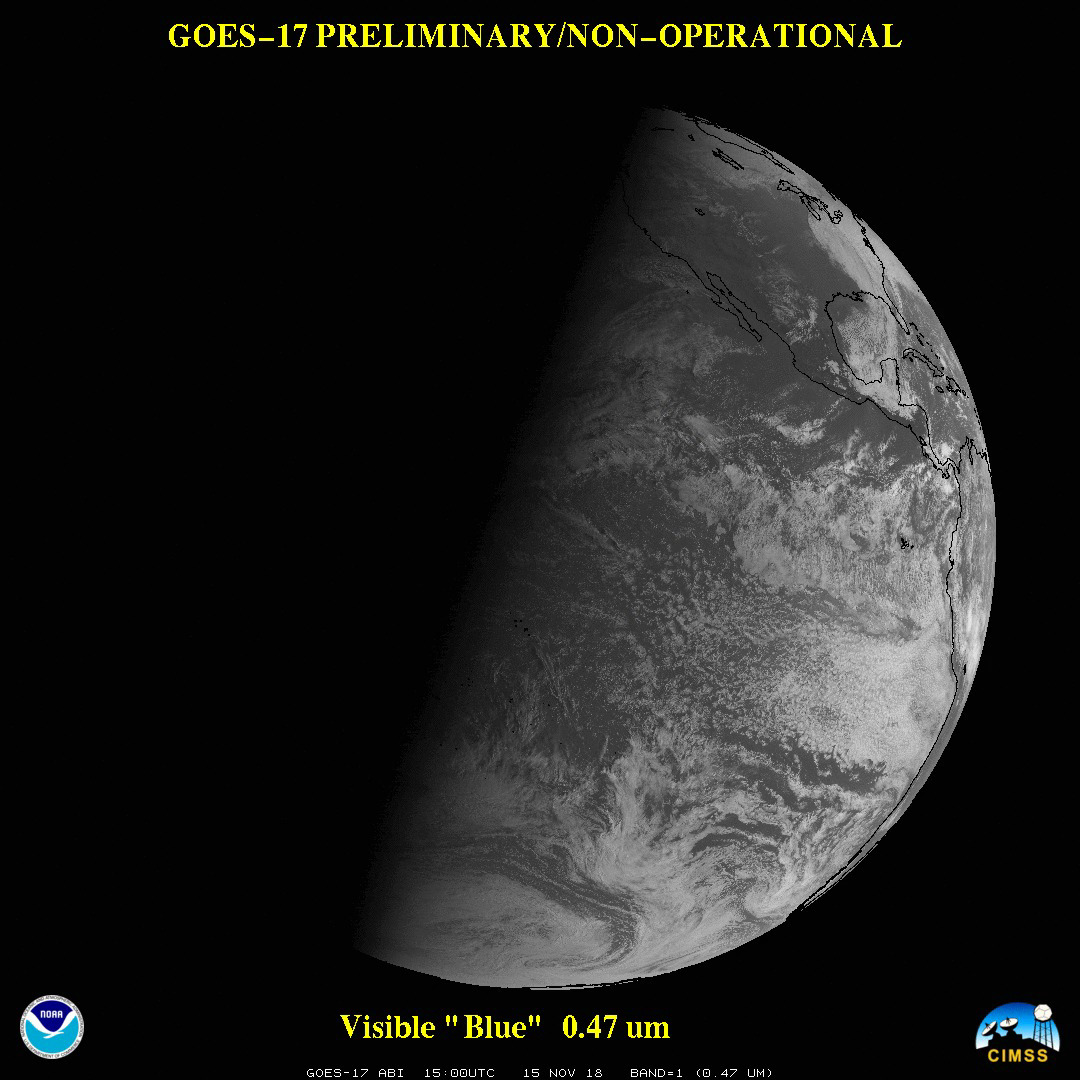
[ Archive ]

 |
CIMSS-NOAA Weekly Report [ Archive ] |
 |
ASPB AND CIMSS WEEKLY HIGHLIGHTS FOR THE WEEK ENDING NOVEMBER 16, 2018
IN THE PRESS:
SSEC and CIMSS Scientists in the News: Scientists at the University of Wisconsin-Madison (UW) Space Science and Engineering Center (SSEC) and the Cooperative Institute for Meteorological Satellite Studies (CIMSS) provide expert commentary, interviews, and imagery to news media and participate in events to promote science. In the news this week: 1) CIMSS Satellite blog contributor Scott Bachmeier's most recent post covered GOES-17 as it arrived at its GOES-West position of 137.2º W longitude on November 13, 2018 and began to transmit imagery via GOES Re-Broadcast (GRB) at 1500 UTC and the AWIPS Satellite Broadcast Network (SBN) at 1700 UTC on November 15. It will become NOAA's operational GOES West satellite on December 10, 2018. Other posts this week analyzed the "Atmospheric river [that brought] precipitation to south-central Alaska" (Nov. 12), and the "Woolsey Fire in southern California" (Nov. 9). Read more at the CIMSS Satellite Blog: http://cimss.ssec.wisc.edu/goes/blog/. 2) NOAA announced its Listening Session with Dr. Neil Jacobs on November 26, 2018, 2-4 pm at Union South in Madison, WI. Dr. Jacobs will provide an overview of his NOAA priorities for implementation of the Weather Research and Forecasting Innovation Act of 2017. More information: https://go.wisc.edu/36l2v0. (S. Bachmeier, CIMSS, J. Phillips, SSEC)
 (Click image to enlarge)
(Click image to enlarge)
Figure: Full disk images of the 16 ABI bands from GOES-17 at 1500 UTC: https://go.wisc.edu/t024jx. Credit: CIMSS, NOAA.
ITEMS FOR THE ADMINISTRATOR:
ITEMS FOR THE ASSISTANT ADMINISTRATOR:
ITEMS FOR THE OFFICE DIRECTOR, STAR:
Paper Published on Satellite-derived Winds Impacts in Navy Models: A manuscript has been published in Weather and Forecasting describing a novel approach to assimilating high spatiotemporal atmospheric motion vectors (AMVs) derived from GOES rapid-scans in applications to tropical cyclone forecasts. The dynamic initialization scheme is used to demonstrate the real-time capabilities that are now routinely available with the GOES-R series of advanced imagers. (Elsberry, R.L., E.A. Hendricks, C.S. Velden, M.M. Bell, M. Peng, E. Casas, and Q. Zhao, 2018: Demonstration with Special TCI-15 Datasets of Potential Impacts of New-Generation Satellite Atmospheric Motion Vectors on Navy Regional and Global Models. Wea. Forecasting, 33, 1617–1637, https://doi.org/10.1175/WAF-D-17-0168.1.) (C. Velden, CIMSS, 608-262-9168)
Taiwan Central Weather Bureau Visit: As part of a collaborative project between the Taiwanese Central Weather Bureau (CWB) and the Cooperative Institute for Meteorological Satellite Studies (CIMSS), Michael Foster and Wayne Feltz attended a meeting at CWB to report on work done this past year. CWB funds CIMSS to help transition CIMSS decision support products for the Japan Meteorological Agency's (JMA) Himawari-8 Advanced Himawari Imager (AHI). Applications this year include typhoon intensity estimation, sea surface temperature, and visualization of products in an operational environment. The ongoing project includes contributions from several CIMSS research groups. (M. Foster, CIMSS, 608-261-1361, W. Feltz, CIMSS, 608-265-6283)
Consultative Meeting in China: Dr. W. Paul Menzel attended the fifth meeting of the International Strategic Consultative Committee (ISCC-5) that took place 12-16 November 2018 in Chengdu, China. The session was co-chaired by Dr. Tillmann Mohr, Germany, and Dr. Yu Xinwen, Chinese Meteorological Administration (CMA) and it was attended fifteen international experts and by fifty eight experts from China. The meeting focused on the Belt and Road initiative of China to support countries along the silk road and nearby oceans, planning assessment of data from the Chinese geostationary sounder (GIIRS – Geostationary Interferometric Infrared Sounder) and the pending early morning polar orbiting Fengyun-3E to be launched in 2019, and Chinese satellite contributions to climate data records. ISCC-5 produced 18 recommendations which were accepted for consideration by CMA. (P. Menzel, CIMSS, 608-263-4930, paulm@ssec.wisc.edu)
ITEMS FOR THE DIVISION CHIEF, CoRP:
GOES-17 Data from 137.2 W: Cooperative Institute for Meteorological Satellite Studies (CIMSS) and the Advanced Satellite Products Branch (ASPB) assisted in verifying the Geostationary Operational Environmental Satellite (GOES)-17 Advanced Baseline Imager (ABI) data from it's new position centered at 137.2 W. The Space Science and Engineering Center (SSEC) Satellite Data Services (SDS) acquired the GOES-R ReBroadcast (GRB). The quality of the data was as expected. All the sectors and spectral bands were investigated. Several of these images were used in the NOAA NESDIS article (https://www.nesdis.noaa.gov/content/noaa-goes-17-shares-first-images-alaska-hawaii-and-pacific) or in social media by NOAA and GOES-R communications. (J. Nelson, CIMSS, 608-263-6013, M. Gunshor, CIMSS, R. Kohrs, SSEC, T. Schmit, E/RA2, 608-263-0291)
(Click image to enlarge)
Figure: This Mollweide projection shows a composite of Geostationary Operational Environmental Satellite (GOES)-17 and -16 Advanced Baseline Imager (ABI) band 10 (water vapor) data. The image was generated by Rick Kohrs, SSEC. (https://twitter.com/NOAASatellites/status/1063422646354878464)
Middle School Students visit CIMSS: Two dozen students from the Cardinal Heights Middle School in Sun Prairie WI, all members of the Black Students Union at their school, toured the Space Science and Engineering Center (SSEC) on 12 November 2018. The students had a hands-on activity using the Satellite Information Familiarization Tool (SIFT), developed at the Cooperative Institute for Meteorological Satellite Studies (CIMSS), to investigate differences between Advanced Baseline Imager (ABI) bands on GOES-16 in regions before and after fires; they viewed weather on the 3-D Globe, received information on Antarctic Meteorological Research, and viewed presentations on Tornadoes and Hurricanes. The activities were designed to foster interest in the sciences and to demonstrate how programming is important in atmospheric sciences. This visit was a coordinated effort with the Office of Precollege/Youth Programming and Compliance in the UW-Madison Division of Continuing Studies and was designed to include underrepresented groups in Science/Technology/Engineering/Math (STEM) fields. (M. Mooney, SSEC/CIMSS, 608 265 2123; S. Lindstrom, SSEC/CIMSS, 608 263 4425; D. Mikolajczyk, SSEC/CIMSS/AMRC, 608 262 0780; L. Orf, SSEC/CIMSS; D. Herndon SSEC/CIMSS, 608 262 6741)
VISITORS:
NEXT WEEK:
LOOKING AHEAD:
| Archived Weeklies Page | Submit a report item |